THE MACKAY FALLEN PART II: ROBERT STALKER Alan Bowker (Article)

Alan Bowker
The MacKay Fallen, Part II: Robert Alexander Stalker
by Dr. Alan Bowker

Robert Stalker c. 1914: From an image provided by a descendant
Robert Stalker was born in London, England, on February 22, 1879, the second son of George Frederick Stalker, an eminent Scottish architect who had come to Ottawa in 1883, and his wife Clarinda (1849-1930). In all the couple had nine children, the youngest an infant, when George died suddenly in 1895. He appears to have left enough money for his widow and family to live in an attached house at 37 Charles Street in New Edinburgh (shown below as it is today). Clarinda Stalker joined MacKay Presbyterian church in 1909 along with three of her sons. She was a stalwart in the Ladies’ Aid and was one of the church’s Visitors to the Protestant Hospital.[1] But tragedy continued to dog the family. None of the four daughters survived past early adulthood: three died of TB and the infant died at age 4 of pneumonia.
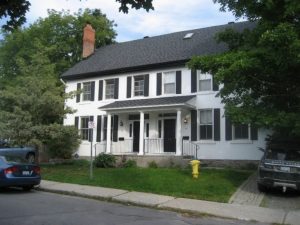
House at 37 Charles Street New Edinburgh as it appears today (it is the right side of the double house). Photo by author 2015
Robert and his four brothers, however, escaped this dreaded disease, and participated in the vibrant New Edinburgh athletic scene, which included rowing, football, track, and hockey. Around 1901 he and his elder brother George moved to Golden, British Columbia, where he is recorded in the census as a General Store Clerk making $500 a year. According to a descendant, Robert met his wife, Anna Kenny, there, but because she was Catholic they had to go to Revelstoke to marry in 1904.
In 1909, Robert and his family moved to Prince Rupert, worked for a year in a grocery store, then started his own store, Stalker and Wells.[2] The business did well enough that Stalker could build his own house and have a $5000 life insurance policy. Unfortunately, in 1913 Anna died of a perforated ulcer, leaving him a widower with four young children.[3] His mother-in-law, Martha Kenny, who had raised eight children of her own, took them back to her home in Golden. But in 1914 Robert brought Martha and the children back to Prince Rupert.
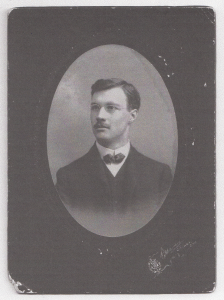
A younger Robert Stalker. Image provided by a descendant.
On May 1, 1916 Robert enlisted in Comox, BC, as a lieutenant in the 102nd battalion of Northern BC. Another of Martha’s daughters moved to Prince Rupert to help with the children. Stalker, like his older brother George, had military experience. He had been a member for four years of the 68th regiment, Earl Grey’s Own Rifles based in Prince Rupert, and before that he had served for three years in the 43rd Duke of Connaught’s Own Rifles, an elite Vancouver regiment. We may still raise our eyebrows at a 37-year-old widower with four small children and a business enlisting in what by 1916 would clearly be no glorious adventure; but by then enlistment requirements had been relaxed and such a thing was not uncommon.
The 102nd Battalion was called the “buck twos” or “Warden’s Warriors” after its commanding officer, Lieutenant-Colonel John Warden. Most its men were drawn from the Earl Grey’s, together with some leftovers from the Duke of Connaught’s and some men from the interior of British Columbia.[4] The first recruits to arrive at the training camp in Comox suffered severe hardships because the camp was not ready, but Stalker and the Prince Rupert men did not join them until the spring when the headquarters and administrative staff were well established and training could begin in earnest. Oddly enough, neither he nor any of the other officers in the 102nd (Northern BC) Battalion, as it was now called, was assigned a service number. He was 5’ 8”, expanded chest 35”, and gave as his NOK his daughter Jean in Prince Rupert, who was a child of seven.
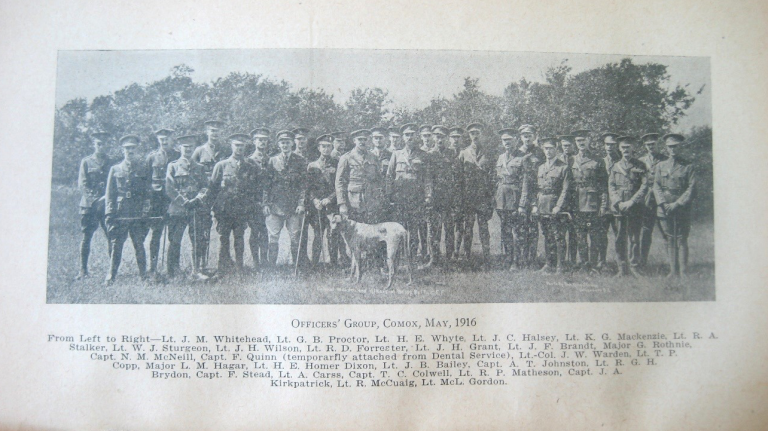
Officers Group 1916. Stalker pictured sixth from the left. Picture taken from Leonard McLeod Gould, From B. C. to Baisieux, being the narrative history of the 102 nd Canadian Infantry Battalion. Victoria, B.B.: privately printed, 1919, on-line at http://www.102ndbattalioncef.ca/warpages/102chap 1.htm
Warden pulled strings to get the 102nd sent overseas as quickly as possible and on June 10, 1916 they embarked for Vancouver and a long train trip across Canada, with stops for parades in a number of cities and towns. On June 18 they were loaded on the CPR “Empress of Britain” at Halifax and two days later sailed with an escort ship. The weather was calm but the ship was carrying three battalions and the food was atrocious. They landed in Liverpool on June 28 and reached their training camp near Bramshott on June 30. There, in the words of an early historian of the Battalion, “when the authorities found out that we were the tallest, the heaviest, and the most maturely aged of any unit that had reached England”, the 102nd was incorporated directly into the 11th Brigade of the newly formed 4th Division. They then had to undergo six weeks of rigorous training to catch up with the rest of the Division, weed out unfit officers, discard under-age boys, and have their equipment replaced with standard issue. They had only two weekends’ leave, one of which was cut short so that Sam Hughes could inspect the division. (“We surely did love our Minister of Militia when this news came through.”) On a sweltering hot August 11, 1916, the 102nd entrained for Southampton, proceeded to Le Havre, and at midnight the next day found themselves on a “side-door Pullman” trip to Belgium that lasted a day and a night.[5]
But Robert Stalker was not with them, for on August 14, 1916, he was married again, at Marylebone in London, to Edith Boult, a 36-year-old Englishwoman. Stalker was presumably given a few days’ special leave and joined his company in Belgium.[6]
There is a mystery surrounding this marriage. Edith Stalker is mentioned only once in Stalker’s service record as a person to be notified in case of casualty; the names usually given are his mother or his brother Moray, or a Mrs. Gordon Melville in Hurlingham, England, whose relation to him is not known. Throughout his service, money from his pay was sent to Mrs. Kenny for the care of the children. When he was wounded (see below) Edith was living in Liverpool – whether she travelled to London to be with him is not clear; he does not appear to have gone there.[7]
Edith had, one might say, an interesting background. Her father, Peter Rawlinson (Rollo) Boult, appears to have been a habitual criminal who spent much of the 1880s and 1890s in prison for forgery, embezzlement and other offenses, and Edith and her brother were raised by her mother and grandmother.[8] After Edith’s mother died in 1893 she seems to have been increasingly on her own.[9] Rollo Boult was sentenced once again to prison for forgery in 1897, and when released in 1898 he declared his intention to travel to the United States – his son had gone to New York in that year. However, in 1902 Rollo was once again sentenced to a year in prison in Nottingham.[10] That same year Edith travelled to the United States and in 1904 she married one Ernest Bordat, a French national, in Fall River, Massachusetts.[11] What happened to this marriage is not clear, but in 1911 she was also back in England, living in Islington with her father.[12]Then in 1914 she and Rollo travelled to Prince Rupert, where they lived for two years. She likely met Stalker there and may have travelled to Britain at the same time as he was shipped overseas.[13]
When Stalker rejoined the 102nd, it was in the St. Eloi sector of the Ypres salient getting “put wise” to trench warfare by being rotated, company by company, into the line to be paired with more experienced units. This was officially a “quiet” time, but the 102nd suffered the usual “wastage” from snipers and shells, and on September 7 Stalker joined the list of casualties with a bullet wound to his left arm.[14] He passed through field hospitals to No. 14 General Hospital in Boulogne, before being sent to England and admitted on September 9 to “Mrs. Pollock’s Hospital”, London, for convalescence. Although the bullet had passed through the left forearm without breaking bones or leaving any foreign matter, it proved slow to heal and Stalker went through two monthly medical boards before he was cleared to return to duty on November 16, 1916. He thus missed the terrible battles on the Somme which took a high toll on his battalion. When he rejoined his unit on December 30, 1916, it was rebuilding and preparing for the attack on Vimy Ridge. In February, Stalker was dispatched for a week’s training as a platoon commander and in March he was sent for training in preparation for the coming battle.
In early April the men began training on a course taped out on the grounds of their base camp. The 4th Division had a particularly difficult assignment: on the northern flank of the Canadian battlefront, it would attack against heavily fortified and well dug-in troops, facing heavy fire and determined defenders. The 102nd, with the 87th on its left, would take the first leg of the attack on Hill 145; after they reached their objective, two other battalions would pass through them and capture the high point that was absolutely essential if the Canadians were to take and hold the ridge.
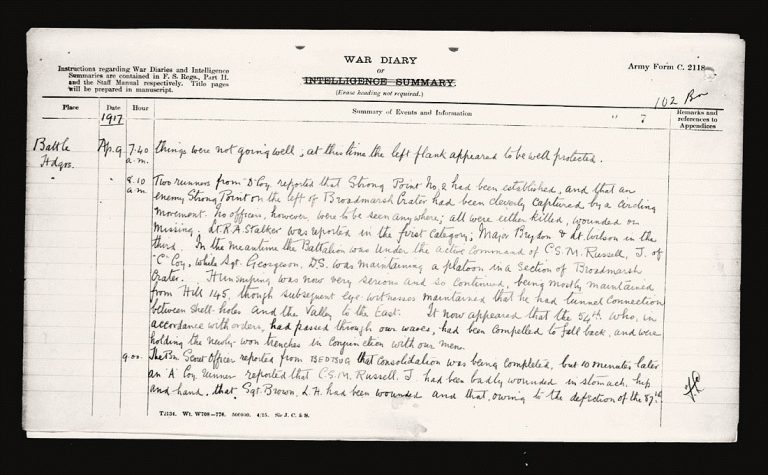
Page from war diary can be accessed through http://canadiangreatwarproject.com/WarDiaries/diarySummaryLocation.asp?Unit=102nd+Batt alion&offset=250
On April 9, 1917, in a blinding snowstorm, the 102nd went “over the top.” Its war diary reflects the confusion of its headquarters in the fog of battle. Initial reports from runners were good but within a couple of hours it was clear that “things were not going well.” The attack on their left had stalled and with its flank unsupported the 11th Brigade’s attack dissolved in shambles, and the 102nd were exposed to murderous machine gun and artillery fire. When they finally reached their objective, all the officers of the 102nd had been killed or wounded; and for an intense hour, while it desperately held onto its position against repeated counter-attacks, the battalion was commanded by a seriously wounded Company Sergeant Major. Stalker was killed early in the battle; according to the battalion war diary his death was confirmed by a runner at 8:10 a.m.[15] By the end of the day the 102nd was finished as an effective fighting unit.
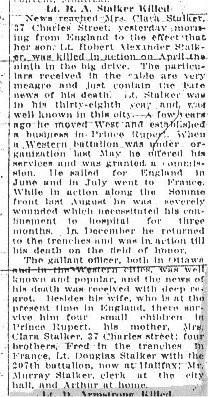
Clipping announcing Stalker’s death, paper unknown, posted on the Canadian Virtual War Memorial page for Robert Stalker.
Strangely, as a businessman with four small children, Robert Stalker had left no will. Ordinary soldiers were encouraged to make one, usually on a page in their paybook, but officers were not required to do so. He apparently did settle his debts and his business obligations before he left. But though Mrs. Kenny was listed on his service records as the guardian of his children, and was receiving monthly payments for their support, he had made no formal arrangements for their guardianship.
Within a month of his death, in May 1917, his widow Edith and her father Rollo Boult arrived in Halifax on the Olympic,[16] travelled on to Prince Rupert, and took the children away (it is not known to where). In August a probate court approved her claim that as Stalker’s lawful wife she was the administrator of his estate, subject to a security of $200 and taking an oath that she would pay all just debts and administer the estate in a fair manner and render true account. His estate – some $200 with no debts, and no real property, investments, or securities – was divided between Edith Stalker, who got $66.66, and the four children who got $33.33 each.[17]
Mrs. Kenny could not do much about the estate, but she could, and did, do something about Stalker’s $5000 life insurance policy, of which his eldest daughter Jean was the beneficiary, and his final military payments and the pensions and benefits for the children. In May 1918, an application was made to the British Columbia Supreme Court on behalf of the four children, “by their next friend Martha Kenny”. According to a Prince Rupert newspaper she claimed that “Edith Stalker is not a fit woman to have charge of the young people,” and Edith and Rollo were forced to “produce” the four children before the court.[18] On September 12, Mr. Justice W. A. Macdonald heard the case in chambers, with affidavits by Mrs. Kenny, Nora Kenny (her daughter), and witnesses who knew the family, as well as Edith Stalker and Rollo Boult, with lawyers pleading the case for both parties and for the Official Guardian. He ordered “that Martha Kenny, of Prince Rupert, British Columbia, widow, be and she is hereby appointed guardian of persons of the said infants […] during their respective minorities until other order shall be made to the contrary”, and that the costs of the Official Guardian would be paid out of their estate.[19] The family returned to Prince Rupert. We may assume that the pension amounts for the children, and other amounts owing to Stalker, were paid to Mrs. Kenny, and Stalker’s medals and decorations were sent to his eldest son c/o Mrs. Kenny in 1920.[20]
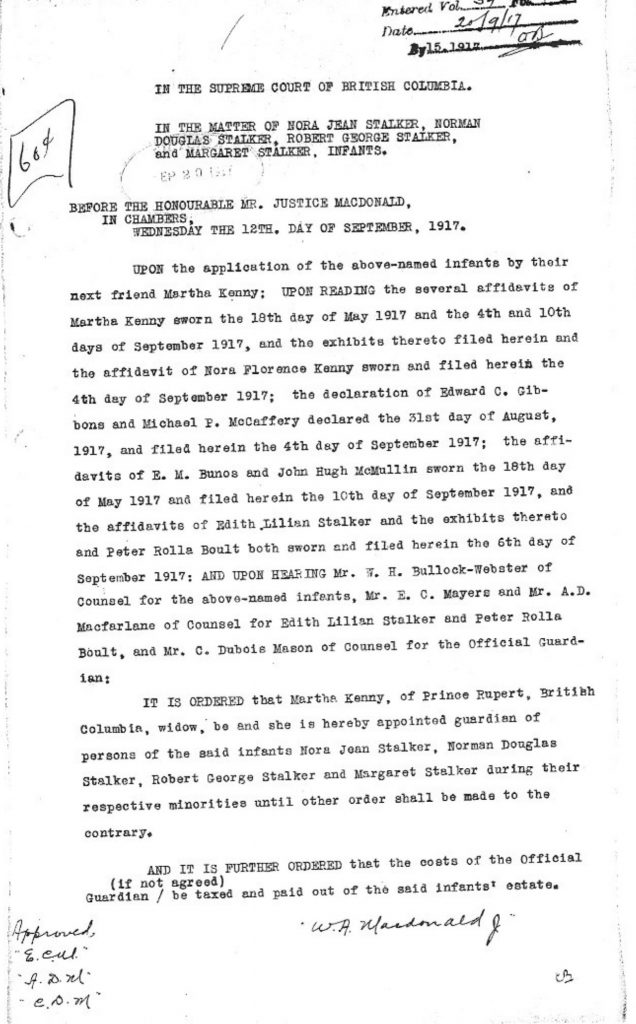
In The Supreme Court Of British Columbia. In The Matter Of Nora Jean Stalker, Norman Douglas Stalker, Robert George Stalker, And Margaret Stalker, Infants, Before The Honourable Mr. Justice Macdonald, In Chambers, Wednesday The 12 th Day Of September, 1917. Provincial Archives of British Columbia, Supreme Court records.
Edith Stalker did not take long to recover from her defeat. On January 5, 1918, now resident in Victoria B. C., she married Lieutenant Colin James Morris in Vancouver. Morris was a 33-year-old bachelor who had immigrated from England in 1905 and worked as a commercial agent. He had joined the First Division Canadian Field Artillery at Valcartier in 1914, had been promoted to Sergeant and then Lieutenant in the field, had been wounded and discharged with injuries to both knees.[21] Edith declared herself a widow, occupation housekeeper, age 30 (she was actually in her 39th year).[22]Apparently, this union did not last, because on June 24, 1920, Morris, now divorced, married again.[23] But Edith was not yet finished. On June 13, 1921, declaring her age as 35, she married Francis John Beattie Cox, 25, a bachelor farmer from Manitoba, in Toronto.[24] They may have moved back to England, where he may have died in 1935. Her father died in New York in 1924. What happened to Edith we do not know.
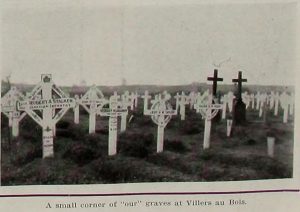
Stalker’s original grave marker, paper unknown, posted on the Canadian Virtual War Memorial page for Robert Stalker.
The stories of men who fell in the Great War reveal the courage of men facing death on the battlefield. Less well recognized is the courage of those at home who carry on, in the face of stress, hardship, and loss. And of Martha Kenny, who fought in the courts – an expensive process and difficult terrain for a woman in her position at that time – to regain her four grandchildren, and then raised them in what must have been challenging circumstances. Besides the pensions for the children, the $5000 life insurance policy was doled out to her by the Official Guardian in instalments of $458 per annum, except for an amount of $244.13 that was retained to pay the government’s commission under the Official Guardian’s Act. In 1927, Mrs. Kenny successfully petitioned the Government to pay her this money since she “being a widow, is having difficulty in meeting expenses in connection with the maintenance of the children.”[25] Martha Kenny died in 1937 at 76 and is buried with her daughter Anna Stalker in Fairview Cemetery, Prince Rupert.[26]

Executive Council of BC Decision http://www.bclaws.ca/civix/document/id/oic/arc_oic/0437_1927
Back in Ottawa, the courage of Mrs. Clarinda Stalker, herself no stranger to tragedy, was also being tested. After Robert’s death in April 1917 her eldest son was badly wounded at Passchendaele, and her youngest son was in the same battle and in early 1918 was slightly wounded as well (their stories will be told in the next two blogs in this series). Another son, Moray became the point of contact for the brothers overseas and managed her affairs. Meanwhile, Clarinda led the Ladies’ Aid in prayer, worked tirelessly making jam to donate to the Protestant hospital, knitted socks and assembled parcels for soldiers, made clothes for the Red Cross, and held bake and rummage sales or concerts and socials to raise money for the Sunday School and Building Fund. She, like the other mothers in the “little band of faithful” watched and waited for news from the front and prayed that it would not be bad.[27]

Villiers Station Cemetery: photo by Carolyn Bowker, October 2015
Robert Alexander Stalker’s body was taken to the Villiers Station Cemetery near the small village of Villers-au-Bois, about 11 kilometres from Arras. This cemetery was used mostly for Canadian burials from late 1916 to the middle of 1917, with a few in 1918; it contains 1009 Canadians, 179 British, 205 Australians, and 32 Germans, who are unidentified and buried in a row marked with a single headstone. Set in the middle of a large open field, it is laid out with the gravestones at an angle to the main axis and the Great Cross. There are large Canadian maple trees around the perimeter and plants including a number of roses along the rows of stones. When we visited in October 2016 the land was shrouded in fog with the Canadian maples beginning to change colour, and the bucolic peace of this simple cemetery belied the many months of fierce and unrelenting carnage in the Arras sector from which men were brought for burial day after day. Robert Stalker lies near the middle of the cemetery with a few rows of other men who fell at Vimy.

Robert Stalker gravestone: photo by Carolyn Bowker, October 2015
After the war her surviving sons rebuilt their lives, married, and established careers. Clarinda Stalker continued to attend MacKay Presbyterian, as it rapidly expanded and then became MacKay United. She remained one of the Church’s Visitors to the Protestant Hospital and was on the the Executive Committee of the Ladies Aid until 1924. In 1930 she died at home and was buried at Beechwood cemetery – in the words of the MacKay Death Register, “an old and honoured member of MacKay church.”
ALAN BOWKER served for thirty-five years in Canada's foreign service, including as High Commissioner to Guyana. He has a PhD in Canadian history and has taught at Royal Military College. He lives in Ottawa. His latest book is A Time Such as There Never Was Before: Canada After the Great War. He has also edited two collections of essays by Stephen Leacock, whom he considers one of the most perceptive commentators on early twentieth-century Canada.
FOOTNOTES
[1] MacKay Presbyterian Church, Minutes of the Ladies’ Aid 1902-14. The Protestant Hospital is now Wallis House on Rideau Street.
[2] 1911 census. Prince Rupert City Directory 1913. Danielle Dalton, ed., Book of Rainbows: Stories of Cultural Diversity Making a Difference. Prince Rupert: Hecate Strait Employment Development Society, 2013, 185-6. A descendant provided me with further information on the business and the city.
[3] British Columbia Death Registrations, 1872-1986; 1992-1993″, database, FamilySearch (https://familysearch.org/ark:/61903/1:1:FL2S-HRZ : accessed 30 September 2015), Mary Anna Stalker, 1913.
[4] Swift and Strong: The British Columbia Regiment (Duke of Connaught’s Own): A Pictorial History. Vancouver: British Columbia Regiment (Duke of Connaught’s Own) Museum Society, [1981], 107, 72
[5] Leonard McLeod Gould, From B. C. to Baisieux, being the narrative history of the 102nd Canadian Infantry Battalion. Victoria, B.B.: privately printed, 1919, accessed on-line at http://www.102ndbattalioncef.ca/, chapters 1, 2. This is a first-hand account by a Sergeant with a lively literary style and a worms-eye view of the battalion, who had access to the war diaries and other official records.
[6] Marriage register England and Wales, available on ancestry.ca (verified 06/08/2018)
[7] “Mrs. R. A. Stalker (wife) 16 Garden Terrace, Liverpool” supersedes Mrs. Gordon Melville in Hurlingham on one document; on all other documents including in his medical file during convalescence in the fall of 1916 Mrs. Melville and the Bank of Montreal, Waterloo Place SW are entered under “Remarks” and no mention is made of Edith.
[8] His profile on ancestry.ca (verified 06/08/2018) has links to documentary sources, as does the profile of Edith Boult. (verified 06/08/2018) The 1881 and 1891 censuses of England (available on ancestry.ca) list him as a prisoner in both the 1881 and 1891, and show Edith, her mother, and her brother William residing with her grandmother. (verified 06/08/2018)
[9] A record of a London workhouse in 1899 (available on ancestry.ca) shows an Edith Boult entering on June 13, 1899, a son Frederick born June 24 and dying August 10, and Edith discharged at her own request on August 16, 1899. It cannot be corroborated that this is “our” Edith Boult as her birth date is given as 1882. (verified 06/08/2018)
[10] The family tree of Peter Rawlinson Boult on ancestry.ca , quotes from or links to documentary sources; while this cannot be considered definitive it appears credible. (verified 06/08/2018)
[11] Massachusetts Marriage Register available at ancestry.ca (verified 06/08/2018). For William see https://www.ancestry.ca/family-tree/person/tree/70847487/person/44503619974/facts (verified 06/08/2018). This is supported by links to U. S. documents which shows that he lived in the New York area until his death in 1956. His father Rollo appears to have been living with him in 1924 when he died, and he may or may not have gone briefly to New York with him in 1898.
[12]1911 census of England and Wales (available on ancestry.ca) shows her as 32 years old, born in Cheshire, living with her father, Peter Rawlinson Boult, 57, a journalist, widowed, in Islington. (On the marriage register in 1916 her age is given as 35, not 36, one of many examples of her elastic approach to her age.) Birth record 1879, November 2, ancestry.ca (verified 06/08/2018)
[13] See register of her landing in Halifax in May 1917 on ancestry.ca, where she declares that she had been in Canada before, in Prince Rupert, for two years, presumably starting in 1914. She declares her age (again) as 35. Her destination is Prince Rupert (verified 06/08/2018). It is not clear why she and her father travelled to Prince Rupert in 1914. One R. Oscar Boult was already living there, who may have been a relative.
[14] His service record is quite clear as to the date. Peter Hughes, Visiting the Fallen – Arras North says he was wounded at St Eloi on July 8, 1916, which is not possible. A newspaper account of his death has him arriving in France in July but wounded on the Somme front in August. This is also in error.
[15] http://canadiangreatwarproject.com/WarDiaries/diarySummaryLocation.asp?Unit=102nd+Battalion&offset=250(verified 06/08/2018) Causes of Death Register entries are missing for S-Z. Swift and Strong, 109, gives a number of 214 dead, wounded, and missing during the battle and details many individual acts of heroism. For descriptions of the 4thDivision in the Vimy Ridge battle see Tim Cook, Shock Troops, chapter 8, and his excellent new book, Vimy: The Battle and the Legend. Toronto: Allen Lane, 2017, chapters 3-5, and especially pp. 96-113
[16] Passenger List for Olympic, available at ancestry.ca (verified 06/08/2018).
[17] Archives of British Columbia, Victoria, File GR-2202.523 – Stalker, Robert. Accession 87-0710. Reel B09033, Number Probate 33065; and GR-1483.463 – Stalker, Robert A. Reel 09395 Probate 441/1917. Documents concerning probate of the will of Robert A. Stalker, Prince Rupert
[18] Prince Rupert Daily News, September 10, 1917, copy of a clipping provided by a descendant.
[19] IN THE SPUREME COURT OF BRITISH COLUMBIA. IN THE MATTER OF NORA JEAN STALKER, NORMAN DOUGLAS STALKER, ROBERT GEORGE STALKER, and MARGARET STALKER, INFANTS, BEFORE THE HONOURABLE MR. JUSTICE MACDONALD, IN CHAMBERS, WEDNESDAY THE 12TH DAY OF STEPMBER, 1917. Provincial Archives of British Columbia, Victoria Supreme Court Judgements, vol. 34, fol. 428.
[20] His records show that a memorial cross was sent to his mother Clara in 1922.
[21] For his service file http://central.bac-lac.gc.ca/.item/?op=pdf&app=CEF&id=B6385-S057
[22] Marriage record, available at ancestry.ca (verified 06/08/2018). He died in 1933 at age 49. His grave marker makes no mention of her. (Edith gives the name of her father as Rollo Boult on the marriage register. https://www.findagrave.com/cgi-bin/fg.cgi?page=gr&GRid=26287276&ref=acom
[23] Marriage Registers 1857-1932, McCartney-Morris, available at ancestry.ca (verified 06/08/2018).
[24] Marriage resiter, available at ancesry.ca (verified 06/08/2018).
[25] http://www.bclaws.ca/civix/document/id/oic/arc_oic/0437_1927
[26] https://www.findagrave.com/cgi-bin/fg.cgi?page=pv&GRid=52675714&PIpi=33862150 A descendant has graciously provided me with information on Stalker’s family and the custody battle.
[27] MacKay Presbyterian Church, Minutes of Ladies Aid 1914-1924, 62.
This article first appeared in The Journal of Military History (Sir Wilfred Laurier University) accessible via this link
Tags: Alan Bowker
